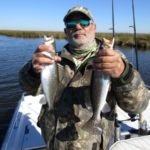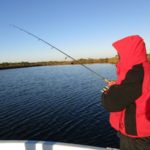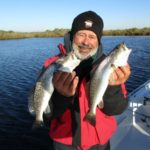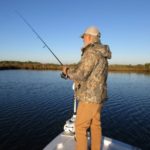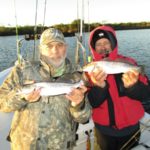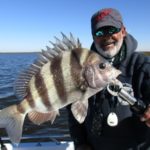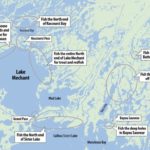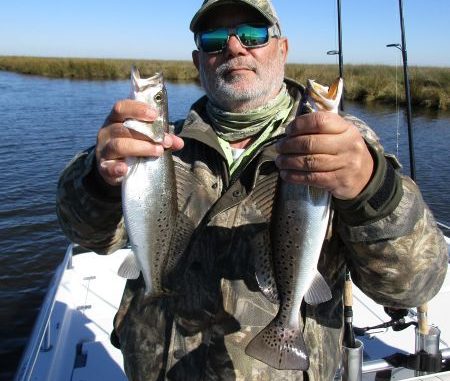
The menu at Dularge this month features trout, reds and sheepshead, but you have to slow things down. Here’s how and where this veteran guide keeps catching limits.
So, I waited all night for the call that never came. I was so sure it would come — certain even. But it didn’t.
And that’s why I found myself bundling up like an Eskimo to go fishing on what the weatherman called “the coldest day of the year so far.”
I had a fishing trip scheduled out of Dularge with Capt. Gerald Ellender, but I was sure he’d call and cancel due to the bone-chilling frigid forecast.
What I didn’t know is that “Ellender” is an old Houma Indian word that means “he who fishes when its freezing.”
Or if it doesn’t mean that, it should.
My truck’s temperature gauge read 38 degrees as I headed toward Dularge, mumbling to myself about how we must both be crazy to even consider fishing in this cold. I half hoped he wouldn’t be at the dock but home sleeping where sane people were, thinking I had sense enough not to leave home under such conditions.
But no, he was there, all bundled up against the cold. And another foolhardy angler with him.
Both looked glad to see me and were ready to get underway, even in dawn’s early light.
Ellender introduced me to his longtime buddy and retired airplane pilot Jerome Pitre, and the three of us climbed aboard the captain’s 24-foot bay boat and pushed off from the dock.
And here’s what I discovered: If you really dress for the cold — thermal undies, fleece- or flannel-lined pants, long-sleeve T-shirt, another shirt, heavy socks, gloves and coat, neck gaiter, etc — you’re still gonna be cold.
Especially on the boat ride.
Thankfully, our ride wasn’t too long or painful. I pretty much hid behind them, and, while I was cold, it was bearable.
And He-who-fishes-when-its-freezing said the fish had been biting up until this cold spell, but he thought we could still do some good.
“I don’t think its been cold enough for long enough to send them all deep to the bottom, so we’ll fish them today in several ways and in several spots, including some relatively shallow areas, under corks,” Ellender said.
I was game, so once the Power-Pole went down I pulled off the gloves and started casting with a cork rig.
I had a Vudu shrimp on, generally an excellent producer under most conditions, but it was mostly ignored early that morning.
Pitre was tight-lining something chartreuse that was treated by the fish with equal disdain, while Ellender fished a double rig loaded with avocado-colored B-2 squid, also under a cork.
It was Ellender who got the first bite. And the second.
Pitre switched to the same thing and also caught fish.
“This area is called the Tank Battery Canal, and its a well-known hotspot this time of year,” Ellender said. “I figured we’d catch some trout and perhaps a few reds back in here, because when it gets cold the fish gather up in these dead-end canals.
“The dead-ends off Bayou Sauveur and in Bayou Sauveur itself are good, especially in the deeper holes. The water in the dead-ends is, on average, 5 to 6 feet deep — and the colder it gets the more the fish will snug the bottom. We catch reds with leeches all over their belly, so you know they’re snug on the bottom.”
But the fish weren’t stacked up on this day.
They were scattered, so we trolled around to see if we could bump into a few more.
I switched to a double rig I had already set up, using a pair of sparkle beetles that hadserved me well on a previous trip. One beetle was chartreuse, one a clear/red fleck, and they dangled beneath a cork.
I finally managed a single fish, while both Ellender and Pitre were spanking them pretty well.
“Put one of these B-2s on,” Ellender said, tossing a bag of avocado-colored baits to me.
I was familiar with the lures because I’ve used them for years as “trailers” when I used to troll the MRGO back before Katrina, and even now when I troll along the Causeway.
I’ll pull a Rapala or MirrOlure with a B-2 trailer about 18 to 24 inches behind it, with a treble hook hidden inside.
But these guys were using B-2s on jigheads. So, I pulled off the clear beetle and snugged a plastic on a hook and, yes, I started catching fish.
Coincidence? Actually, I suspect it was the darker avocado color that made the difference, and that probably any bait in the same color would have caught that day. But I didn’t have anything that color in my bag of tricks, so I can’t say for sure.
“Some call that a motor oil color or avocado or just dark green. Be sure to have some when you fish out here this month,” Ellender said.
I figure if that’s a good winter color in Dularge, it’ll work elsewhere, so I’ve since added a bag of avocado H&H beetles to my arsenal.
Which brings up another point Ellender made.
“Use smaller baits,” he explained. “Winter is time to downsize, and double up. Smaller baits on double rigs under a cork are great choices in milder weather, between fronts or even on chilly days when the sun is up.
“You can fish them on the bottom on colder days, but you may have to use heavier jigheads, depending on the depth of the water and the current.”
And he said that, when fishing them under a cork, you shouldn’t pop the cork as often or as vigorously as you do in the spring or fall.
“Do everything slower and deeper and smaller,” Ellender said.
The fishing guide said the Dularge area will hold some great fishing this winter, even on colder days.
“The good thing is our real cold weather doesn’t last long,” he said. “It blows in and out over a matter of a couple days, and then we get a warm-up.
While we focused on the Tank Battery Canal and the around Bayou Sauveur, Ellender said there are spots all around Dularge that will produce.
“I have about a half dozen other areas I like to fish during the winter that produce fish consistently — mostly trout, reds and sheepshead,” he explained. “Find an area with a shall bottom, and fish with market shrimp on a Carolina rig and you’ll catch sheepshead and reds and probably some puppy drum.
“Fish ledges along deep holes in the turns of bayous for all the above, plus trout and flounder.”
Here’s a rundown of the area’s hotspots:
1) Lake Mechant — The whole north end of the lake holds reds and trout. The northeast side is excellent, as is the north end on both sides of Raccourci Bayou, and the west side of Lake Mechant between Goose Bay and Bayou Raccourci.
All these areas hold fish.
“Fish along the banks because that’s where they’ll be,” Ellender said. “The water warms up faster in shallower water, and you can fish them under a popping cork.
“I usually troll and stick. Troll until you bump into some fish; then stick your Power-Pole or Cajun anchor, and give it a few minutes before you move on.”
2) Raccourci Bay — The whole north shoreline of Raccourci Bay can be fished the same way as Lake Mechant.
“Work along the shoreline for reds, and you’ll catch some bass, too, this month,” the guide said. “The winds usually blow from the north this time of year, so those northern shorelines are lee, and you can do good even when its windy.”
3) Raccourci Bayou — This is the main pass between Raccourci Bay and Lake Mechant.
“I like to fish the north end of Raccourci Bayou on an incoming tide and the south end on a falling tide,” Ellender said. “We catch everything in there this month, from trout, reds, black drum, big croaker, flounder and sheepshead.
“Fish the bottom with crab or market shrimp on a Carolina rig. Fish the ledges with market shrimp for flounder.”
4) Goose Bay — “I fish the main points at the mouth of Goose Bay at Lake Mechant, and then I’ll move into Goose Bay and fish anywhere along the entire shoreline for redfish with a gold spoon,” Ellender said. “Then you can try the canal on the west side of Goose Bay, which has a deep hole (about 18 feet deep), and bull reds and drum like to stack up in it.
“Cracked crab fished on the bottom will put a bend in your rod in there.”
5) Sister Lake — The extreme north side of Sister Lake (aka Caillou Lake) holds both trout and reds, and can produce when fished under a cork or tight-lined.
6) Grand Pass — This deep pass between Lake Mechant and its sister lake (Lake Caillou) holds bull reds, bull drum and sheepshead.
Ellender said the bottom and sides are mostly oyster shells, and the pass is 40 to 50 feet deep.
“But the fish aren’t hanging on the bottom in 50 feet of water — they’re along the ledges on the sides,” he said. “Fish crab or market shrimp with a ¾- to 1-ounce sinker and a No. 4 or No. 6 kahle hook, Carolina-rigged.
“The fish hang out on both the east and west sides of the pass. On an incoming tide I fish the north end and on a falling tide I fish the south end.”
Meanwhile, our ice chest was looking very respectable, as we continually added fish to the box.
As the morning wore on and the sun peeked out and warmed us up ever so slightly, the fish started biting on other baits more readily.
I caught some on H&H beetles and on Vudu shrimp, while Ellender stayed with the B-2s. Pitre went back to tight-lining, using a glow/chartreuse H&H cocahoe, and he caught fish steadily.
“Perhaps the most-important advice I can give anglers this month, besides dressing warm, is to slow down your presentation,” Ellender said. “Do everything slower than you think necessary. And when you think you’re fishing slow enough, fish even slower. Even on milder days, don’t pop your cork as often or as vigorously.
“When you fish the bottom, lift and reel ever so slowly. And when you feel even a slight tap, set the hook; the bite will be very light this month.”
Slowing down extends past your lure retrieve, however.
“My last piece of advice is when you pull up to a spot you have to give it time to produce,” Ellender said. “This is not spring or summer, where you make a few casts and if nothing hits you pull up and move.
“Slow yourself down this month, too, and give a good, likely spot time to turn on. More often than not, you’ll be glad you did.”
Editor’s note: Capt. Gerald Ellender can be reached at 985-688-1715.
